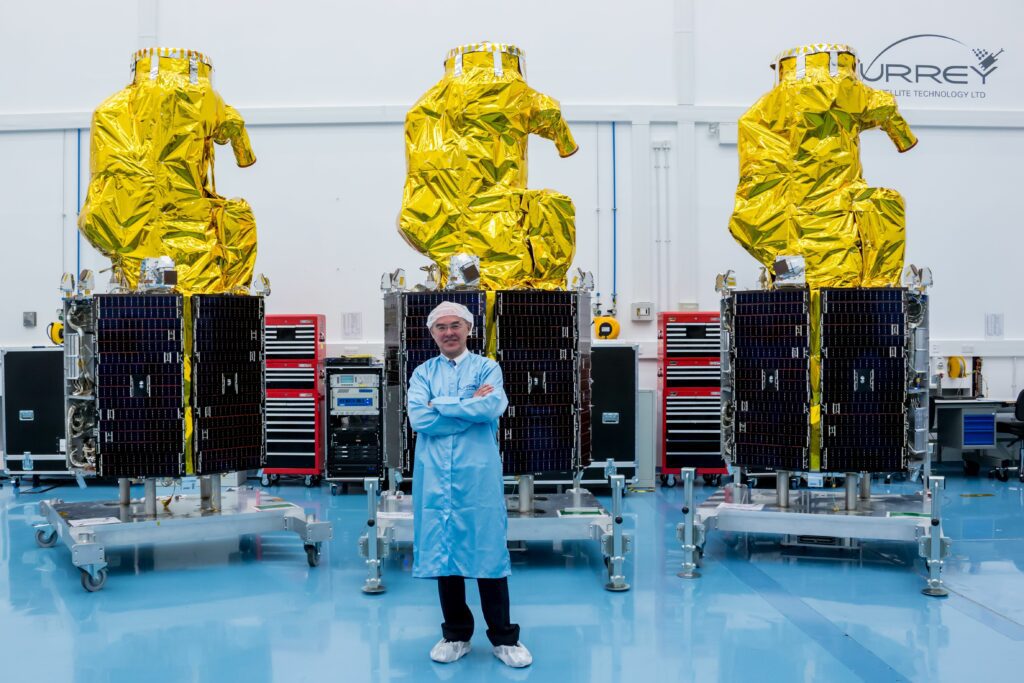Farah Ghouri finds out the status of the Lunar Pathfinder project, why the cubesat bubble is far from bursting, and how it will be “quite interesting” to discover life beyond Earth, from Sir Martin Sweeting, chief executive of Surrey Satellite Technology Limited (SSTL) and the man hailed as the ‘father of small satellites’.
Sir Martin Sweeting has no plans for retirement from SSTL, the first small satellite technology firm in the world, which he founded almost 40 years ago with capital of just GBP£100. In fact, the British company’s executive chairman is looking as far ahead as 2075 by running a study for the Royal Society to look at the implications of space for society over the next half century.

Although his involvement in SSTL is unwavering, the company has gone through some changes of its own. It was bought in 2009 by Astrium which, in 2013, became Airbus Defence and Space through a merger with Cassidian and the Airbus Military divisions of European Aeronautic Defence and Space Company (EADS). Initially SSTL acted as an almost autonomous subsidiary of Airbus. More control has since been exercised by its parent company but Sir Martin notes that SSTL still retains “a high degree of independence”. He compares the evolving relationship to that between a parent and a teenage child (SSTL): “as with your parents, you tend to keep them informed of what you’re doing…and they might occasionally express an opinion”.
Sir Martin is proud of SSTL’s provision of technology transfer and training programmes to countries that include the Philippines, South Korea and China, a move he believes has helped create a bigger market with more opportunities.
As an advocate of space sustainability, Sir Martin is sheepish, but still candid, about the company’s inadvertent contribution to space traffic by effectively encouraging more satellite launches. “I suppose we are guilty of that,” he admits, though he points out that, to date, SSTL has only launched around 100 satellites, a figure that pales into insignificance compared with the thousands of Starlink satellites launched by SpaceX. Incidentally, Elon Musk was briefly an investor in SSTL. Sir Martin is full of praise for the entrepreneur: “What he [Musk] and SpaceX have achieved is quite remarkable.”
SSTL’s relatively small satellite footprint has stemmed from its focus on smaller disaster monitoring satellites and payloads for Galileo navsats. However, upscaling its operations to larger constellations is not completely off the table. Sir Martin notes that SSTL has received inquiries to build 100 satellites or more. While the company is currently limited to a more modest capacity, he says “we are now very actively looking at participation in Oneweb…and if we can capture that, then it gives us the mechanism to expand our facilities to be in a position to manufacture some of these larger constellations.” So, watch this space.
The long-awaited Lunar Pathfinder – and the Moon missions that need it
The mission Sir Martin is most excited about is SSTL’s Lunar Pathfinder, a satellite that could, if successful, establish affordable communications services for lunar missions. It has been a long time in the making – the mission first appeared on SSTL’s roadmap 24 years ago. The Moon fascinates Sir Martin, who doesn’t hesitate when asked if he would take a tourist flight there: he would, provided it was safe and affordable. The recent spate of Lunar lander missions are, in his view, paving the way for the next phase of lunar activity: permanent habitable bases.
The idea of bases on the lunar surface has been heralded since the 1950s. Plans for these were re-energised in the early 2000s when the space industry predicted they would be needed for a human mission to Mars by 2023. Of course, that mark was missed but the father of smallsats has noticed that “the tempo has changed and I think the political environment has changed,” with countries such as India and China unabashedly targeting the Moon. “I’d be surprised if we weren’t there [building lunar bases] by 2030.”
What is the progress of the Lunar Pathfinder project? “Progress is pretty good. I was in the US last week discussing that with NASA, who are one of the players, and potential users, alongside ESA and others. The spacecraft is well underway and it will be completed before the end of this year. Then, essentially, we will be waiting for the launch which is – through the NASA CLPS programme – currently on Firefly, which we hope is going to be in early 2025, but it’s up to the launcher schedule.”
Of course, after the failed Peregrine lander carrying NASA payloads and the troubles that beset JAXA’s SLIM project, getting the mission right remains key to SSTL. With many more lunar missions predicted, Sir Martin says the Lunar Pathfinder will be critical to relaying data back from the Moon.
So, will SSTL be renting out its services, like a service provider, and then receiving the revenues? “Exactly. We are obligated to ESA and NASA to run the service. They are funding us to do the mission, but in return they get the service. So, it is a sort of service provision, but it’s a slightly embryonic process. While ESA and NASA might get their services free, other users have to pay for their relayed signals depending on how much bandwidth they use.”
How big do you expect the Cislunar economy to be? “Very hard to say. I think the sustained human habitation or prolonged human habitation on the moon is going to require significant infrastructure to support it. So, I think you’re going see good business for the private sector, funded from government sources in the initial stages and then, as it becomes established, you will start to see some more pure commercial exploitation on the lunar surface and other services.”
When are we likely to see Lunar bases on the Moon? “I think we will be there by the end of this decade, ideally by 2027. But I’d be surprised if we weren’t there by 2030.”

Courtesy: SSTL
Launch vehicles, the cost of OTVs and the cubesat ‘bubble’
What are your thoughts on the growing number of small launch vehicles in development? “There are many – maybe too many because I can’t see all of them being able to survive. There have been a whole range of small launches proposed over the last 30 years and very few of them have succeeded. Technically it might be possible but you’ve got to make money out of it. It’s always cheaper, at the moment, to go on a big launcher. It’s very difficult for small rockets to be as competitive in dollars per kilo as a big rocket.
“Their advantage is that they can launch more easily when you want and to the exact orbit you want. So, you can get a bespoke launch, but you pay extra for that and so it depends on whether customers are prepared to pay more for a dedicated launch. Now, if they can bring the launch cost way down – to be able to compete with SpaceX, for example – and you can have an adequate envelope in the launcher (enough space to fit your larger satellites in), then there may be a business there. But head-to-head on cost per kilogram, I think they’re going to find it very tight. So, I think there’ll be room for maybe just five of these kinds of companies.”
Are orbital transfer vehicles (OTVS) more expensive to launch on than dedicated rides? “In that sense, you’re paying for the extra ride to go exactly to your desired destination. It’s an alternative to the dedicated launch (the small dedicated launcher), but if you take one of those additional taxi rides on top of the cost of the launch – well we haven’t used it because it’s been more costly.”
About a decade ago you suggested that we might see a cubesat bubble. Is the bubble for smaller satellites over?
“Well, I don’t think that the bubble is going to burst. What we saw was that in the early days, around 2015, small nanosatellites and cubesats (a configuration of nanosats) meant that it was possible for startups, universities and some new space nations to get a very low-cost entry into space. But the operational utility of these very tiny satellites was rather limited. So, in the beginning, there was quite a flurry because this was an opportunity for people to get access, some experience and to dip their fingers in the space water, at very low cost.
“And then, after a while, as they became familiar with space, they wanted to have real applications. In other words, they wanted these nanosats to earn their keep. Now, these tiny satellites have rather limited power and a limited ability to carry payloads, so the 10 kg satellites got fatter and bigger because they needed to grow to between 20 and 50 kg to generate enough power to carry big enough payload sensors in order to be really useful. And I think if you look at the number of the smallsats being launched, the peak is probably in the 50–75 kg range for real applications.”
Seradata analysis shows a flattening, albeit with large fluctuations, in the number of 1-10 kg class nanosats launched annually, whereas launches of 10-100 kg class small satellites are rapidly rising.
Beyond satellites
Another mission that Sir Martin is looking forward to is NASA’s Clipper mission to Europa, the smallest of four moons orbiting Jupiter. He remains hopeful that it might find something spectacular: “I’m fairly sure that sometime in the next 10 to 15 years we will come to the conclusion that there is evidence of life elsewhere and the implications of that are going to be quite interesting to think about.”
When he’s not pondering what extraterrestrial life could be like, Sir Martin enjoys experimenting with radios and antennas, a hobby that drew him into the space industry. These days, when he has fewer opportunities to play with satellites, it serves as his “antidote to space”. He is also an enthusiastic radio amateur, or “ham”, and happily declares that his call sign is G3YJO.







